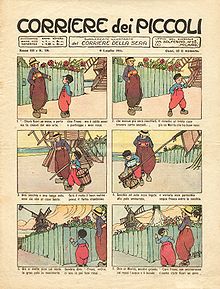- Corriere dei Piccoli
-
The Corriere dei Piccoli (Italian for "Courier of the Little Ones"), later renamed Corriere dei Ragazzi ("Children’s Courier") and nicknamed Corrierino ("Little Courier"), was a weekly magazine for children published in Italy from 1908 to 1995. It was the first Italian periodical to make a regular feature of publishing comic strips.
Contents
Publication history
The first issue (24 pages, 80,000 copies) was published on December 27, 1908, with Silvio Spaventa Filippi as editor-in-chief. It was formally a supplement of the magazine Corriere della Sera, but it was also sold separately for 0.10 lira[1] At its acme, the magazine sold 700,000 copies.
By 1970 the magazine started having financial difficulties due to rising costs and competition by other magazines and comics books. Feeling that the quaint name was partly to blame, on January 1, 1972 the publisher renamed the bulk of the magazine Corriere dei Ragazzi, which hopefully would be more appealing to teenagers. The name Corriere dei Piccoli survived as the title of a thin supplement of the publication, aimed at the younger readers.
The last issue was dated August 15, 1995.
Contents
Throughout its history, the Corrierino published material in many genres: stories in comic strip format, illustrated tales and novels (usually in half-page to two-page weekly installments), educational material, feature columns, humor, news, reviews, readers' letters, puzzles, board games, and more.
Although comic strips had been published before in Italian children’s magazines—Il novellino had published American examples including, in 1904, a Yellow Kid cartoon—the Corriere was the first to make them a regular feature and the first to commission original Italian artwork as well as using American strips.[2] A typically Italian comic strip format was introduced by the Corrierino from its first issue. The full page was divided into six equal panels, in three rows. Instead of text balloons (which were already used in the US, but were considered educationally regressive by the Italian editors), the narrative and dialogue were provided by octosyllabic rhymed couplets underneath each panel, e.g.:
Qui comincia l'avventura "Here begins the adventure Del Signor Bonaventura ... of Mr. Bonaventura ... " In time this format gave way to balloon-captioned comics, which, besides being the universal norm outside Italy, made for more lively action and dialogue, and gave more freedom to the artists in the choice of panel size and layout. Nevertheless, strips in this "Italian format" continued to make sporadic appearances throughout the life of the magazine, generally aimed at younger readers.
Influence
Besides introducing comics to Italian public, the Corrierino greatly influenced four generations of Italians, and played a significant role in the career of many Italian artists and writers, such as Giana Anguissola, Mino Milani, Hugo Pratt, Lino Penati, Dino Battaglia, Aldo Di Gennaro, Sergio Toppi, Mario Uggeri, Benito Jacovitti, Guido Buzzelli and many more.
See also
- Il giornalino della Domenica, a children’s magazine founded in Florence in 1906.
- Il Vittorioso, a Catholic children's magazine from Italy.
- Spirou, a famous Belgian magazine for children.
- Tintin, also a Belgian example.
Notes
- ^ Its upmarket rival Il giornalino della Domenica, founded in 1906, sold for two and a half times the price.
- ^ Encyclopedia of Italian Literary Studies, ed. by Gaetana Marrone and others, (New York; London: Routledge, 2007), I, p. 787. ISBN 9781579583903.
Categories:- Publications established in 1908
- Publications disestablished in 1995
- Italian children's magazines
- Media in Milan
- Defunct magazines of Italy
Wikimedia Foundation. 2010.

